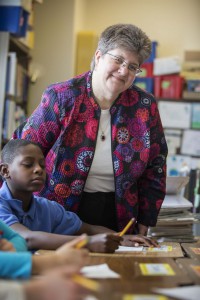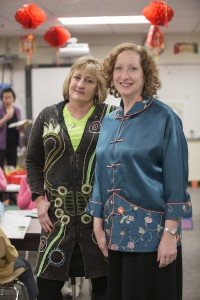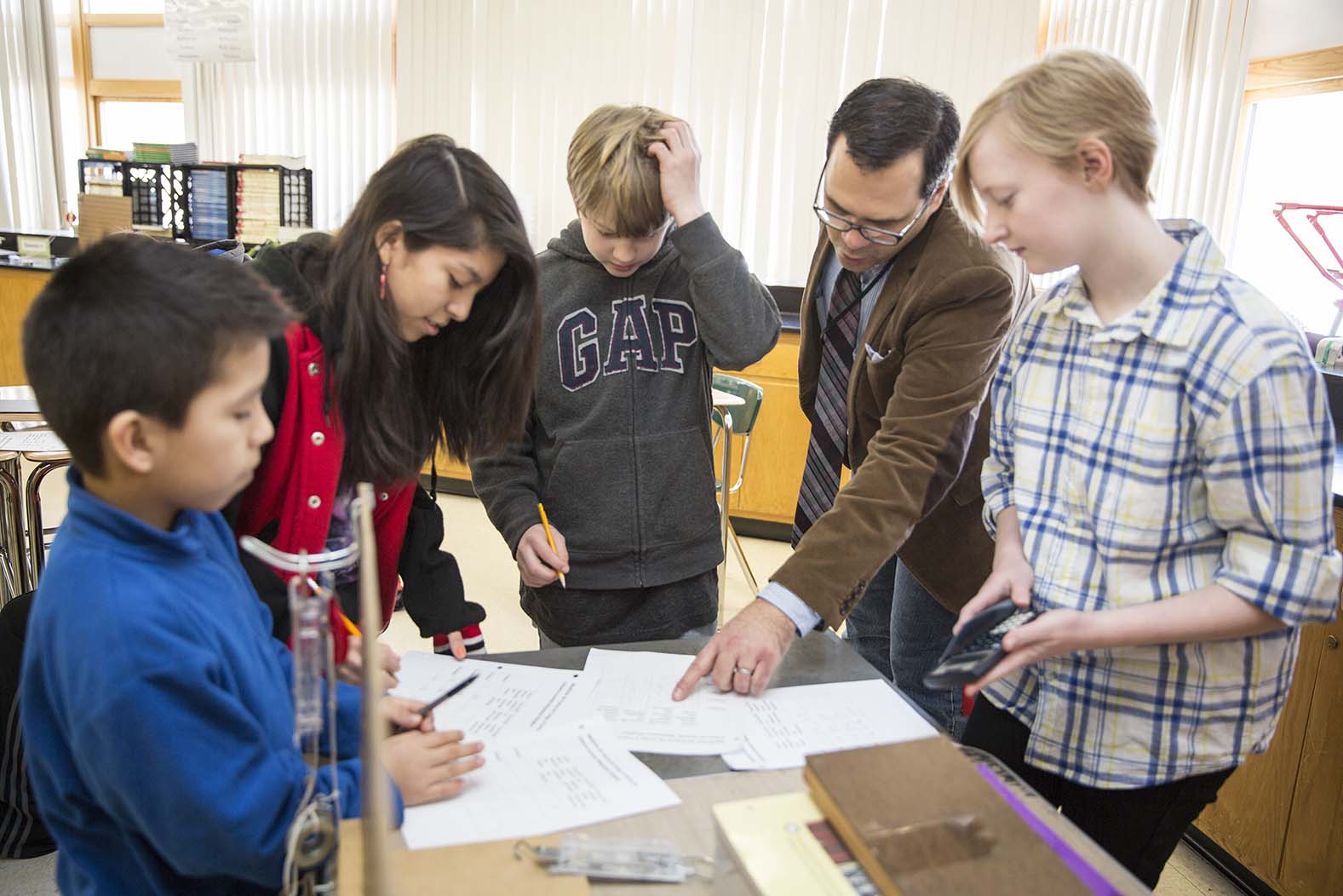Anwatin Middle School is a giant circle of classrooms around a courtyard. The woods of Theodore Wirth Park in Minneapolis form the backdrop. But the bigger backdrop is the world.
Enter Anwatin and you stand in a foyer flooded with light falling through the bright fabric of world flags. Listen and you hear English, Spanish, Hmong, Somali, and other African languages. In classrooms, you hear English, Spanish, French, and Japanese. In the hallways and at lunch, conversations slip from one language to another and back depending on the subject matter.
This is Anwatin’s fourth year as an authorized International Baccalaureate (IB) school for Grades 6 through 8. All of the school’s 640 students are in the IB program. But Anwatin is also home to the only Spanish-English two-way middle-school language immersion program in Minneapolis Public Schools. A third of the school’s IB students are enrolled in the immersion program, too.
Two-way immersion is a model that is gaining attention, especially in areas with a substantial population that speaks a language other than English at home. Anwatin is one of the most ethnically and racially diverse in the city; a full two-thirds of its immersion students speak mostly Spanish at home.
The immersion students at Anwatin come from programs including Emerson and Windom in Minneapolis. Many have known each other since kindergarten. At Anwatin they take science and social studies—called humanities here—in Spanish. They also have three years of advanced Spanish language arts, where they read and analyze literature in Spanish. Yet only 4.2 positions in Anwatin’s staff of 70 are devoted to the Spanish side of immersion.

One of those 4.2 positions is the immersion coordinator, Elizabeth Dwight, who reports to principal VaNita Miller, ’93. Dwight and Miller first met and team-taught at Emerson Elementary, then a one-way immersion school that traced its roots to Spanish immersion classrooms at Wilder and Jefferson beginning in the late 1970s. Miller was an immersion teacher when Dwight was hired as Emerson’s first English as a second language teacher in 1993 to work with a surge in students who spoke Spanish at home. Emerson soon became a two-way immersion school.
Twenty years later, Miller and Dwight have become a leadership team, walking quickly through the halls, swapping information in English and Spanish, spreading their sunny dispositions. They have known many of the students and their families for years.
“The big change we’ve seen during our years teaching is that our Latino families have really embraced immersion, too,” says Dwight. “They can see that Spanish is going to be an asset that their kids take into higher education and their careers.”
“Our story is The Little Engine That Could,” says Miller. “Looking at results in a district study last year, we saw really promising signs. Our native English speakers are performing with and above their peers. Among our native Spanish speakers there’s a huge range, and some are hitting the top of the range.”
Accumulating evidence shows that English learners in well-implemented two-way immersion programs do as well as or better than their peers in English-only programs on standardized achievement tests. And two-way immersion is able to serve a significant number of English language learners, who constitute a vulnerable and high-risk population when it comes to student achievement measures.
From Don Miguel to Mandarin
Across Minnesota, dual language and immersion education is booming. From Leech Lake and Duluth to St. Cloud and Rochester, school districts are responding to the demand from parents and communities. This year, more than 85 programs in a total of at least seven languages are in place.
Immersion education is a program model in which teachers who are highly proficient teach subject content—from math to social studies—in the target language. The three broad types include one-way, two-way, and Indigenous language immersion.
The growth in Minnesota reflects a national and international movement. The two-way model was pioneered in Miami-Dade County, Florida, in 1962 by Cuban exiles, who expected their stays to be temporary and did not want their children to lose their native Spanish. The first one-way immersion program was developed in 1965 in Quebec, Canada, by English-speaking parents who wanted their children to become bilingual, well before equal protection for French and English was passed into law in 1982. The first Indigenous immersion programs were developed by the Maori people of New Zealand in the 1980s; in the United States, Hawaiians soon followed suit.
During the ’60s in Minnesota, Howard Hathaway of St. Paul—better known as Don Miguel—taught Spanish on television to students in schools across Minnesota and Wisconsin. Later, as the supervisor for world languages in St. Paul Public Schools, Hathaway received the first grant for bilingual education in Minnesota and started the first English as a second language program. When the magnet school concept was introduced in the 1980s, the superintendent polled the district’s leadership team for themes most likely to succeed.
Hathaway replied immediately. Immersion. The first St. Paul students enrolled in 1986.
Minnesota has been ahead of the wave. And less than 30 years after children experienced its first Spanish immersion classrooms, the state’s first Mandarin Chinese immersion program opened in 2006—Yinghua Academy in Minneapolis—quickly joined by several more.
Proximity and collaboration with Canadian researchers across the border are likely a contributing factor to Minnesota’s early adoption of the immersion model. Another is the University’s Center for Advanced Research on Language Acquisition (CARLA), which draws heavily on expertise in the College of Education and Human Development (CEHD). Established in 1993, CARLA is now one of 15 national Language Resource Centers in the country. Immersion has played a big part in CARLA from the beginning.
“Minnesota stands out,” says Diane “Dee” Tedick, associate professor of second languages and cultures education in CEHD and faculty coordinator of the immersion project at CARLA. “Not only do we have programs in seven languages, but we have all types of immersion models here, and they are more robust.”
For example, most immersion schools nationally are “50-50,” meaning half the school time is spent in English and half in the target language.
“We’re known as the mecca for the ‘early total immersion’ model,” says Tara Fortune, ’01, director of CARLA’s immersion research and professional development programs. “That means students who start immersion school in kindergarten receive no instruction in English until second or third grade. For parents, it feels like a leap of faith.”
Bilingual education has not gone without opposition. “English only” legislation has passed in California, Arizona, and Massachusetts. Yet immersion programs, recognized as the most effective way to learn a language in an academic setting, continue to open and flourish.
If 9/11 convinced the government that bilingual foreign language speakers are essential, the rise of China as an economic power has persuaded business owners and communities, entrepreneurs and environmental advocates. Last year, well over a thousand immersion programs were estimated to be up and running in the United States. Utah, Delaware, and North Carolina are among the states that have launched unprecedented immersion initiatives with generous state support.
Building a staff
In a classic redbrick schoolhouse in St. Paul, Adams Spanish Immersion School is thriving. This is the program that Don Miguel envisioned, now more than 25 years old, a K-5 program with 708 students.

“We’re an ‘urban one-way language immersion program’—that’s how I describe it,” says principal Heidi Bernal, who first came to Adams as an immersion teacher in 1988 and returned three years ago as principal. “It’s different from most one-way programs. In urban settings, you have a more diverse population. Fifty percent of our students at Adams are Latino, but only about five percent come into kindergarten proficient in Spanish, so in many ways, Adams is more of a heritage-language program for them.”
A challenge for Adams this year, she says, is making sure curriculum development matches the new state standards for reading.
“The district will do that for English, but we usually have to do it ourselves for Spanish,” she explains. “We have enough immersion programs now that we’re not invisible anymore, but we’re not the first priority, either, when curriculum in adopted or developed.”
Staffing challenges also come with the territory, especially for new schools.
“You need teachers who are bilingual, are excellent teachers, have the right training and licensure,” Bernal says, “and the right visa!”
Adams employs teachers through the international Amity Institute, this year from seven countries, and engages lots of volunteers managed by a parent resource coordinator. The school is now so well established that Bernal gets email year round asking about job openings and is able to refer queries to lesser-known programs in the state.
Building a community
Across the metro in Hopkins, Eisenhower Community School shares a building with one of Minnesota’s newest immersion programs—XinXing Academy.
XinXing (pronounced Shin-Shing) means “new star.” It opened in 2007, a year after Minnesota’s first Chinese immersion program and the same year as two more in Minnetonka and one in St. Cloud. Within the school of 800 students in grades K-6, XinXing’s enrollment is already 350.

Molly Wieland was Hopkins’ world language coordinator when the conversation about starting an immersion school began. It was October.
“I called Tara Fortune and we had coffee,” says Wieland. As a former U faculty member in French, Wieland had been among those who helped to create CARLA. “Tara gave suggestions. She encouraged us to be bold—we talked about Mandarin. Then she sent me to Larry Leebens in Eden Prairie, where they’d recently opened a Spanish immersion program.”
Leebens said two things that proved to be true, Wieland remembers: “You will have to spend a lot more time on staff training and development than you think, and it will cost more to develop materials.”
By January, Wieland had a proposal. The school board approved it, the site was chosen, and XinXing opened the same fall.
“Immersion is hard, and Mandarin is harder,” Wieland says, shaking her head but smiling. “I didn’t sleep much from then until, well—now! …But every day is new.”
XinXing implemented a comprehensive curriculum that includes science, technology, engineering, and math (STEM). Students consistently score as well or better than their non-immersion peers on the MCA standardized tests of English and math.
Building a strong school community has proven challenging. The Eisenhower building includes learners from the highest and lowest socioeconomics groups in the district. In addition, the teachers who are native speakers of Chinese come from a vastly different educational system that is more teacher- than student-centered, while student-centered classrooms are most effective for immersion.
“We started out thinking we’d keep the Chinese classrooms and teachers together for various reasons that seemed logical and intuitive,” says Wieland. “But to build a school community and a community of teachers, we found that we needed to locate all the classrooms of each grade level together, regardless of program.”
Terri Sigüenza joined Eisenhower as principal in 2009. A bilingual special education teacher with experience in Arizona, Mexico, and Minneapolis, Sigüenza had also worked on a bilingual assessment team and directed English language learning. She wanted to work in a neighborhood school, and she was excited to work with Wieland to make the Chinese immersion program successful.
Together they are making progress, identifying tools for training teachers to lead responsive classrooms, and facilitating communication among students, teachers, and parents.
“Parents still are alarmed when a third grader is getting only an hour of English a day,” says Sigüenza. “But language skills transfer—that’s not solid in people’s belief systems yet.”
Language and the brain
Added to all the reasons for learning a language—economic, national security, cultural heritage—is accumulating evidence that being bilingual is not only natural but also good for the brain. Humans have been coming in contact with other languages for millennia. Bilingualism promotes comparative thinking. And now comes evidence that learning and actively using more than one language from birth may even stave off forms of dementia.
“The earlier the better” has been the general rule for second-language teaching. But bilingual educators know that it isn’t always the case. Having a firm base in a native language aids the acquisition of new ones and is critical for academic success overall. Yet for at least a century, many minority-language parents in the United States have feared speaking their native language, some because they believed it would hinder their children’s progress in English.
Sigüenza is haunted by memories of her first job. In Phoenix she taught bilingual special education to families who would not or could not speak Spanish for fear of punishment. It is a problem she still encounters.
“These children are coming up into school ‘language poor,’” she says. “There has been so little research on bilingualism.”
Those are the kinds of critical questions CEHD and CARLA researchers continue to pursue with the immersion community. A lot of research, for example, assumes monolingualism as the norm, while in many parts of the world, people speak at least two languages.
“We are still developing our understanding of what it means to be emergent bilinguals,” says Fortune.
In the meantime, there is growing recognition of immersion education’s potential to be a powerful tool in addressing the achievement gap.
Vision, courage, and follow-through
Brian McInnes, ’10, was teaching in Ontario when he heard about a new Ojibwe immersion charter school near Hayward, Wisconsin. McInnes, a member of the Wasauksing First Nation and a proficient speaker of Ojibwe, had to see it.
“I came, visited, and thought, ‘I cannot bear to not be part of this!’” he remembers. “In Ontario, things just weren’t getting off the ground. I quit my job and moved. Here they had vision, they had courage, they had the follow-through.”
McInnes remembers Fortune driving to Hayward to conduct a mini-immersion session for the teachers.
“She gave us the scaffolding for delivering content and language together,” he says. “I remember how innovative it seemed at the time, and it made my classroom performance and student learning much better. CARLA has been such a model, so responsive and helpful.”
Among the cofounders of the Waadookodaading school was Mary Hermes, an educator of Native ancestry committed to Indigenous culture and learning. She and McInnes followed similar paths to affiliation with UMD before Hermes came to the Twin Cities campus, joining the faculty in curriculum and instruction in 2012.
“Immersion education is very different for us,” says Hermes. “It’s so much more than being able to get a better job. It’s also spiritual.”

Hermes is working to gain support for Indigenous language programs in Minnesota and western Wisconsin. As many as six new and expanded Indigenous language immersion programs, including Dakota in Minneapolis, are preparing to open this fall.
“So much is going on here that I am just on fire,” she marvels. Between teaching and research, she also attends an adult Ojibwe language immersion camp to keep building her own language proficiency.
In Duluth, McInnes’s work has included cofounding the Enweyang Ojibwe Language Nest for preschoolers. In 2012, when CARLA hosted its fourth international immersion conference, he played a role in organizing a strong presence of Indigenous language immersion educators, including presenters from Hawaii and New Zealand.
“To have the Indigenous immersion strand not only welcome at the conference but represented as a vital stream was so good to see,” he says. “For Indigenous languages, growth of immersion is the single best way we have in this state to make sure children speak their languages. It’s the ultimate social justice initiative.”
Just a little more than a decade since he left Ontario, McInnes sees himself as part of a vibrant, hardworking group of educators in Minnesota and Wisconsin.
“Why would you want to go anywhere else?” he asks.
Read more
Learn more about Indigenous language teaching and learning and see Grassroots IM videos on YouTube. Watch for a story in a future issue of Connect.
Learn more about immersion education at CEHD on the Department of Curriculum and Instruction website, and watch a video about immersion education in Minnesota on CARLA’s immersion webpage.
Read more about CEHD initiatives to support immersion education, including teacher preparation, and about Tedick and Fortune’s work in the related story, “Support for a global movement.”
Learn more about U research on bilingualism and the developing brain in “A mind for learning language” in this issue of Connect.
Story by Gayla Marty | Photos by Greg Helgeson | Spring/Summer 2014
 Anwatin science teacher Augusto Vargas is an engineer from the Dominican Republic who is changing careers. He led an experiment about fuerza, carga, and trabajo—force, load, and work—for his class of immersion sixth graders. They attached loads of metal washers to a pulley system to measure force, recording, calculating, and discussing everything in Spanish.
Anwatin science teacher Augusto Vargas is an engineer from the Dominican Republic who is changing careers. He led an experiment about fuerza, carga, and trabajo—force, load, and work—for his class of immersion sixth graders. They attached loads of metal washers to a pulley system to measure force, recording, calculating, and discussing everything in Spanish.